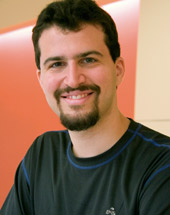Erez Lieberman-Aiden, PhD

Erez studied in applied mathematics at Harvard and as a student at the Harvard–MIT Division of Health Science and Technology. His work integrates mathematical and physical theory with the invention of new technologies. Erez’s thesis was awarded the 2010 Hertz Thesis Prize and the American Physical Society’s Prize for Outstanding Dissertation in Biological Physics. He is currently a junior fellow at the Harvard Society of Fellows. Erez has been described as a “scientific renaissance man.” His work has spanned the fields of mathematics, molecular biology, linguistics, wearable computing, and polymer physics. His most recent invention was a method for three-dimensional genome sequencing; he subsequently led the team that, in 2009, reported the first three dimensional map of the human genome. This paper, featured on the cover of Science, 10/09, is on the Faculty of 1000 list of the all-time Top 10 papers in three different categories: Molecular Biology, Biotechnology and Bioinformatics. In September 2009, Erez was named one of the Technology Review’s TR35 top 35 innovators under 35 and in March 2010 he won the Lemelson-MIT student prize for the best student inventor.
Erez is fascinated by the possibility of enhancing the human senses. His wearable artificial intelligence systems are in use today by NASA astronauts, and are being developed for the next generation space suit. Popular Mechanics named his work on the iShoe, a system for enhancing human balance, one of the top twenty “biotech breakthroughs that will change medicine.”
Erez discovered evolutionary graph theory, a novel approach to population genetics. The work, which (according to the journal Nature) “fizzes with breathtaking brio” has since become a widely-used approach for unraveling the effects of structure on Darwinian evolution.
Erez also showed that the emergence of linguistic rules over the centuries follows an inverse-square principle, the first clear proof that natural selection applies to the evolution of language. This paper appeared on the cover of Nature and was chosen by the editors as one of the best papers of the year.
A recent paper demonstrated a new invention, Hi-C. Hi-C is a method for reconstructing the 3D structure of the human genome. Using Hi-C, Erez and his team discovered the existence of a new type of epigenetic regulation, in which genes migrate in 3D as they are turned on and off. They also observed a never-before-seen polymer configuration, the fractal globule, which enables the genome to pack extremely densely without forming knots. The paper was featured on the cover of Science and was their number one most downloaded paper in October 2009.
In his spare time, Erez and his wife Aviva run a 501(c)(3) nonprofit, Bears Without Borders, that sends thousands of teddy bears to disadvantaged children all over the world.
Graduate Studies
Undergraduate Studies
Awards
2009, TR35, MIT Technology Review
2010, Award for Outstanding Doctoral Thesis Research in Biological Physics, American Physical Society
2010, Hertz Thesis Prize, Fannie & John Hertz Foundation
2011, Director’s New Innovator Award, National Institutes of Health
2010-2013, Society of Fellows, Harvard University